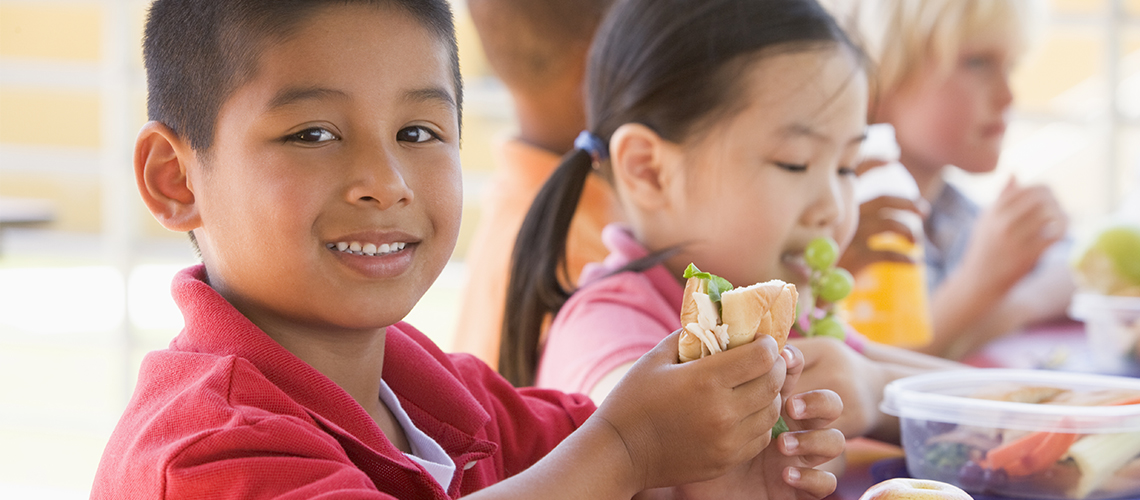the Y
the Y


When packing lunchboxes for our preschoolers, making lunches that are not only convenient, but also include a colourful array of nutritious foods, go a long way in keeping children fuelled for learning.
Children who have eaten well, tend to be ready to engage and have better social interactions with others and are more equipped to concentrate, listen and focus longer.
Lunchboxes are so important in our children’s day, that there is a whole national week dedicated to recognising the significant role of these energy boosting bags, satchels and boxes.
Nutrition Australia’s “Healthy Lunchbox Week” runs 4 – 10 of February, aiming to set you up for the year with ideas and inspiration.
At our kinders, we talk about “Eating a Rainbow.”
By incorporating a range of colours into your child’s lunchbox, you provide a wide spectrum of nutrients that support their growth, immune system, and cognitive development.
For example, red fruits and vegetables like strawberries and tomatoes contain antioxidants that promote heart health, while leafy greens offer a rich source of vitamins and minerals crucial for bone development.
Healthy items to go in lunchboxes include fruit and vegetable sticks, sandwiches, wraps, cheese, tuna, crackers, salad, dips, yoghurt and fruit or cereal. But it certainly doesn’t stop there!
Aim for a selection of foods which will reflect that rainbow! For examples of foods from each of the recommended groups, Nutrition Australia have created this helpful chart.
For an interactive lunchbox builder see the Cancer Council’s Healthy Lunch Box creation tool.
We all get incredibly busy but taking a little time to ensure that you’re stocked up on fresh fruit and vegetables, milk and yoghurt, bread and crackers all help make that pre-kinder prep go much more smoothly.
Buying fruit and vegetables in season or making your own snacks from bulk ingredients not only saves money, but are likely to be better quality. It will also mean that you have some on hand ready to go!
Many items can be prepared the night before and kept in the fridge – helping streamline those mornings.
Assisting your preschooler to help choose and prepare items to go in their lunchbox, provides valuable learning opportunities and encourages self-help skills.
Rather than allowing your child free rein over the pantry, to promote good decisions, limit options. For example, ask if they would prefer kiwi fruit or strawberries, or would like a wrap or a sandwich.
Teaching your child about healthy choices and getting them involved, generates excitement about their food, provides a sense of accomplishment and builds the foundations for healthy eating.
The scheduled hours that your child’s session runs will determine the snacks and meals that you may need to pack. Talk to your child’s teacher if you are unsure about how much is needed. You also know your child best and their individual appetite. Helping your child understand which fresh items should be eaten first and which foods can be eaten afterwards if they still feel hungry, will help reduce wastage.
There’s no doubt about it, water is best.
Don’t forget your child’s drink bottle! Drinks such as cordial, soft drink and even fruit juice contain sugar which is not good for teeth. Additionally, sugar sweetened drinks have little nutritional value and their consumption is linked to contributing to childhood obesity. Non-water drinkers are often encouraged through the example of other children. For a cool summer drink, freeze a small quantity each night and top up with cold water in the morning.
It’s important to keep your child’s lunch cool – to maximise freshness, but also to reduce the likelihood of bacteria growing to unhealthy levels. It may be up to five hours before your child eats their lunch. Pop in a freezer brick or frozen water bottle and choose an insulated option to help keep the temperature down.
Huge amounts of waste in school bins come from lunch packaging. Help look after our environment by choosing rubbish-free lunchboxes, re-usable containers and selecting foods with less to go in the bin. Avoid overloading lunchboxes with food that won’t be eaten.
All our services are allergy aware, and individual services may have restrictions on food to protect those who have severe allergies. For example, while unsalted peanut butter and nuts make a healthy snack for children, please keep these to be enjoyed at home. We aim to keep all children safe, and our service educators will be happy to discuss which foods are suitable at your child’s kinder.
Consider which foods will encourage healthy choices by your child. Foods with high sugar and fat content are best left out. Some of these, such as many muesli bars, even appear “healthy” until you read the ingredients! If a source of sugar, salt or saturated fat is listed in the first three ingredients, it may not be the healthiest option.
Items such as lollies, chips, dairy desserts such as custards and jellies, donuts and creamy cakes, high fat meats such as salami and strass and chocolate bars can be replaced with other alternatives.
Fostering a love of nutritious foods early and spending time creating meals together, sets the stage for a lifetime of healthy eating habits – which is an amazing gift to give a child.
Packing a healthy lunchbox for your preschooler is an investment in their health and well-being, supports their learning and reinforces the teaching that takes place in their kinder’s program.
There are many options and plenty of creative resources out there – so if you find yourself staring blankly at your open cupboard or fridge and wondering how to keep it healthy and varied, check in with a trusted source to help you.
Our educators will have plenty of information and tips to share, and you can find loads of recipe suggestions, examples of how to balance your lunchbox and great ideas on websites such as:
Nutrition Australia’s Lunchbox Recipes
Cancer Council Healthy Lunchbox Recipes
Victorian Government Better Health Channel – Healthy Eating School Lunches
For lunchbox checklists in different languages, see the NSW Government’s multi-cultual resources here.